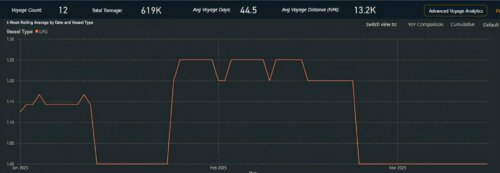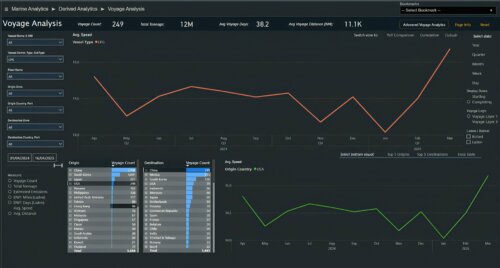The US tariffs implemented on April 5, 2025, have profoundly altered the landscape of global shipping and trade dynamics. With a baseline tariff set at 10% and supplementary tariffs reaching up to 145% on a substantial majority of Chinese exports, coupled with reciprocal tariffs on US goods pegged at 125%, the shipping sector is now coming to terms with both the immediate and long-term ramifications of these trade policies*.
*The information included reflects market developments and available data as of 24 April 2025.
Export patterns and evolving trade dynamics
Historically, China has been a major destination for US volumes; however, recent tariffs are reducing that demand. Now, there’s potential interest in India and Indonesia, where tariff relief could rekindle US cargo interest.
Market movements indicate this shift, with 14 vessels reported to be scheduled for loading in the US Gulf, headed to India and Indonesia in the next month. This is significant, particularly since there have been no US-to-India/Indonesia LPG loadings since late February. This recent activity could mark the onset of a rebalancing in regional demand, particularly if tariff discussions continue to advance.

Route length and tonne-miles
Rerouting from China to India or Indonesia adds distance. On average, the US–India/Indonesia route is around 23% longer than the US–China lane. For LPG carriers, this difference is directly affecting tonne-mile calculations — a key metric when assessing market demand and utilisation.

As longer voyages return, tonne-mile totals will likely rise even if overall volume stays steady. Conversely, if exports are being rerouted to Japan or South Korea, we could see a negative impact on tonne-miles compared to Indonesian and Indian routes, since these routes are typically shorter.
These fluctuations may have increased influence in freight pricing and positioning strategies, especially for owners monitoring utilisation metrics across their fleets.
Fleet behaviour: A reactive market
Alongside the shift in scheduling, recent vessel behaviour points to a market in motion. Sea’s data shows a sharp rise in the percentage of LPG carriers sailing laden — a notable uptick that coincides with the rerouting of US Gulf volumes away from China and toward India and Indonesia.

At the same time, we’re seeing a marked increase in vessel speeds on some US–China routes through late March and early April. While it’s too early to draw firm conclusions, the pattern suggests that some operators may have accelerated sailings to get cargoes landed before tariff conditions changed.
Together, these signs point to a market reacting quickly, whether to new potential cost structures, changes in demand, or the anticipation of further disruption. It’s not a complete pivot, but a clear signal that players are adjusting their strategies in real time.

Adapting to the new normal
For charterers, brokers, and operators, staying on top of a rapidly shifting environment means being able to act fast and adjust with confidence. With freight rates fluctuating and global trade routes and patterns continuing to evolve, the industry’s new normal is being defined by complexity, with market requirements more dynamic and reactive than ever before.
Sea’s unified digital platform supports this new reality. Our solutions help shipping professionals closely monitor the market, track real-time changes, and identify emerging patterns as they happen. From pricing dynamics to shifting trade flows, our platform provides the insights needed to stay one step ahead.
By combining data-driven intelligence with workflow efficiency, Sea enables smarter route planning, faster decision-making, and greater adaptability, key to navigating developments in ocean freight today. As the market continues to adjust, it’s important to have the right tools to move with it, supporting better commercial outcomes, no matter how the landscape changes.
We will closely monitor market shifts, providing accurate and timely insights as conditions progress. To learn more about Sea’s Intelligence and Analytics, click here.
Share this article
Don’t miss the latest news and insights - subscribe to our newsletter
For press enquiries, please email news@sea.live




